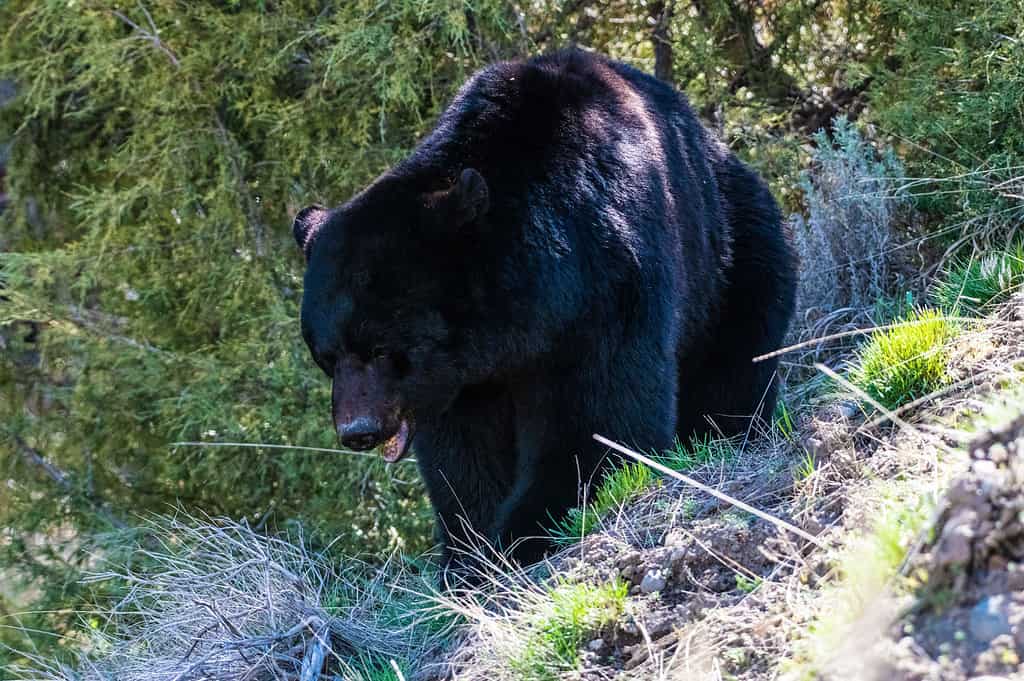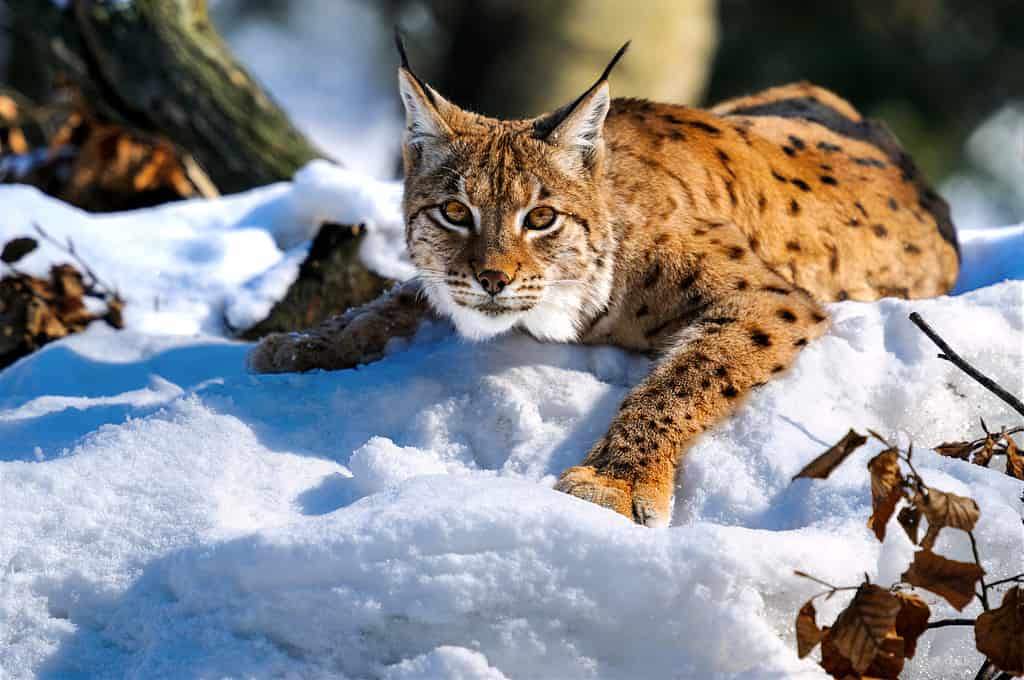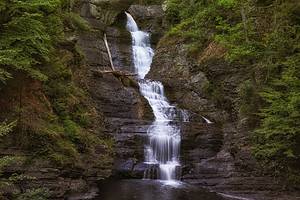In the State of Washington, you will find the beautiful North Cascades National Park, which was established in 1968 to conserve the stunning mountain scenery, glaciers, snowfields, and cascading waterfalls in the North Cascade Range. Furthermore, this region is often called the North American Alps. Within the North Cascades National Park, you will find the tallest waterfall in Washington State, Colonial Creek Falls standing at 2,568 feet tall.
Many people are unaware that the tallest waterfall in the United States is in Washington, just off Highway 20. Colonial Creek Falls is the 15th tallest waterfall in the world and can be seen from North Cascades National Park in the Colonial Basin underneath Colonial Peak.
Wildlife Around the Tallest Waterfall in Washington State
North Cascades National Park is home to an abundance of wildlife. For example, mammals include black bears, mule deer, marmots, and elk. Additionally, there have been sightings of lynx, bobcats, and gray wolves. There are also over 200 different bird species that occur there. These include Steller’s jays, common mergansers, and bald eagles. Lastly, the Skagit River is the only river in Washington with all five salmon species. These include chum, pink, sockeye, chinook, and Coho.
Black Bear
The most common species of bear in the United States is the black bear. These bears are omnivores. Therefore, they eat both plants and meat. Black bears normally live in forests but are known to leave them in search of food. In winter, they hibernate, meaning their heart rate and metabolism slow down. Also, their body temperature decreases significantly.

Black bears inhabit the areas surrounding the tallest waterfall in Washington State.
©iStock.com/John Morrison
Mule Deer
The mule deer is a species of deer also sometimes known as the black-tailed deer. They are indigenous to North America. Furthermore, they were named mule deer because of their mule-like ears. Mule deer live west of the Missouri River and in the Rocky Mountains region of North America. However, they have also been introduced to Argentina.
There are a few sub-species of mule deer, including the white-tailed mule deer. Some differences between white-tailed and mule deer are the size of their ears, the configuration of their antlers, and the color of their tails. These deer’s antlers fall off and regrow each spring. Mule deer can run but prefer to pronk on all four feet.
Marmot
These animals, which are the largest in the squirrel family, are rodents. Marmots found in North America include groundhogs and woodchucks. Furthermore, they live north of the Equator and inhabit:
- Canada
- United States
- Europe
- Asia
These tiny creatures live on plains and highland meadows. They can weigh up to 15 pounds. Also, they have thick fur, short tails, and tiny ears. Marmots are made to dig and therefore have strong claws. They range in color from yellowish to dark brown or sometimes red. Swimming and climbing trees comes easy to these rodents, yet they spend most of their time on or under the ground. Additionally, they build intricate systems of burrows underneath the ground where they live. Marmots eat grass, fruits, and grains, which they store as they hibernate in winter.

Marmots live on plains and highland meadows.
Image: jan ptacek, Shutterstock
©jan ptacek/Shutterstock.com
Elk
Red deer or elk, as they are known, differ in color from tan in summer to dark brown in winter. Also, their head, belly, and neck are darker. They have long ears, and the males have wide antlers. These animals were once abundant throughout the United States, but sadly, hunters have ravished their numbers. These days, they occur in large populations in the western United States and Canada.
Elk occur in open woodlands and do not care for dense forests. In brief, they are common in areas around the tallest waterfall in Washington State and feed on grasses, woody plants, and sedges. Interestingly, elk are ruminant animals, meaning that they regurgitate their food and re-chew it before swallowing, known as chewing cud.
Lynx
Wild cats that live in the forests of Asia, Europe, and North America include the lynx. These cats are known for their excellent eyesight and can weigh up to 45 pounds. Also, they have large fury paws and long legs, which help them navigate snow. Lynxes have thick fur coats to keep them warm in cold weather. Additionally, they are yellowish brown to gray with darker black and brown patches. Furthermore, their ears and tails are black at the tips.
These cats are nocturnal, so they are primarily active at night. They live alone or in small groups and eat small animals and birds. Furthermore, they are good climbers and swimmers. Lastly, the lynx is closely related to the caracal and bobcat. Sometimes the bobcat is known as the bay lynx, and the caracal as the desert lynx.

Lynxes have thick fur coats to keep them warm in cold weather.
©iStock.com/Kyslynskyy
Bobcat
The bobcat, which gets its name from its short or bobbed tail, is a North American wildcat. It is also sometimes known as a bay lynx and is related to the Canada lynx. Bobcats occur in Mexico, Canada, and the United States. Furthermore, they live in forests, deserts, and sometimes suburban neighborhoods. These wildcats are smaller than lynxes but bigger than house cats. They can weigh up to 33 pounds and are yellowish or reddish brown with black spots. Additionally, their tails and ears are black at the tips.
Bobcats are nocturnal, so they are mainly active at night. Their diets include small mammals, birds, rodents, and birds. Bobcats are good swimmers and climbers but prefer to be on the ground. Lastly, they can live up to 12 years.
Gray Wolf
These wolves form part of the dog family and are well known for their courage and intelligence. Also, they can travel long distances. The gray wolf occurs in North America, Asia, and Europe. In addition, North American Indians have been known to name their most powerful warriors after wolves for many years.
The gray wolf is also known as the timber wolf. They have big feet and long legs, and their fur is usually gray but can be black, brown, red, or white. Male gray wolves are larger than females, weighing up to 100 pounds. In addition, wolves are social animals and live in groups called packs. The head of the pack, the male and female, are known as the alpha pair. Lastly, wolves are nocturnal, hunting at night. They will eat things like moose, squirrels, mice, and deer.
Steller’s Jay
The bird known as the Steller’s jay is indigenous to North America and related to the blue jay. These birds have black, blackish-brown, or dark blue heads with rich blue bodies. Furthermore, these cunning birds can be found near picnic tables looking for leftovers. Additionally, their diets consist of nuts, insects, berries, and small mammals such as lizards. Steller’s jays will hide food as winter approaches and stash it for later in the year.
Common Mergansers
Found in Asia, Europe, and North America, the common merganser is a large aquatic sea duck. These birds eat fish and build their nests in trees. Males of this species are white with dark green heads and red bills. However, females are gray with a white chest and rusty-cinnamon head. They will dive under the water to catch fish to eat. Common mergansers live mainly on freshwater lakes and rivers and inhabit areas around the tallest waterfall in Washington State.
Bald Eagles
The national bird of the United States is the bald eagle. These beautiful birds are black or blackish-brown with white heads that stand out and look “bald.” Bald eagles are the only eagles that live exclusively in North America. You will find them near large lakes and rivers. Interestingly, female bald eagles are larger than males, but the coloring is the same. These birds have a varied diet, including small mammals, other birds, snakes, turtles, and crabs. At a time, bald eagles were on the endangered species list. Luckily, they were removed in 2007.

Bald eagles are the only eagles that live exclusively in North America.
©iStock.com/Kandfoto
Salmon
Sockeye salmon spawn in streams that have lakes in their watershed. Young sockeye salmon, known as fry, will spend one to three years in the Skagit River before migrating to the sea. Pink salmon will spawn in the Skagit River only every other year. This is because these types of salmon prefer slow-moving water for spawning. Coho salmon use the shallow areas of the river to spawn. The young will spend one to two years before migrating to the sea. After chum has spawned, the fry will migrate to the ocean, which takes them one to three years. Chinook is the least abundant species of salmon in the Skagit River. Yet, they are the largest and oldest species found there. Chinooks will spend a year or two in freshwater before migrating to sea.
Where is Colonial Creek Falls Located on a Map?
Colonial Creek Falls is the tallest waterfall in the U.S. It is more than 4,200 feet tall, and falls at a staggering 2,568 feet vertically in 13 different drops with an average incline of about 65 degrees. These falls are massive!
Here is Colonial Creek Fall on a map:
The photo featured at the top of this post is © Wirestock Creators/Shutterstock.com
Thank you for reading! Have some feedback for us? Contact the AZ Animals editorial team.






